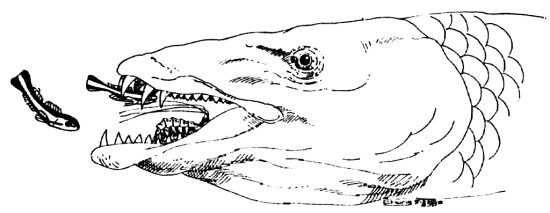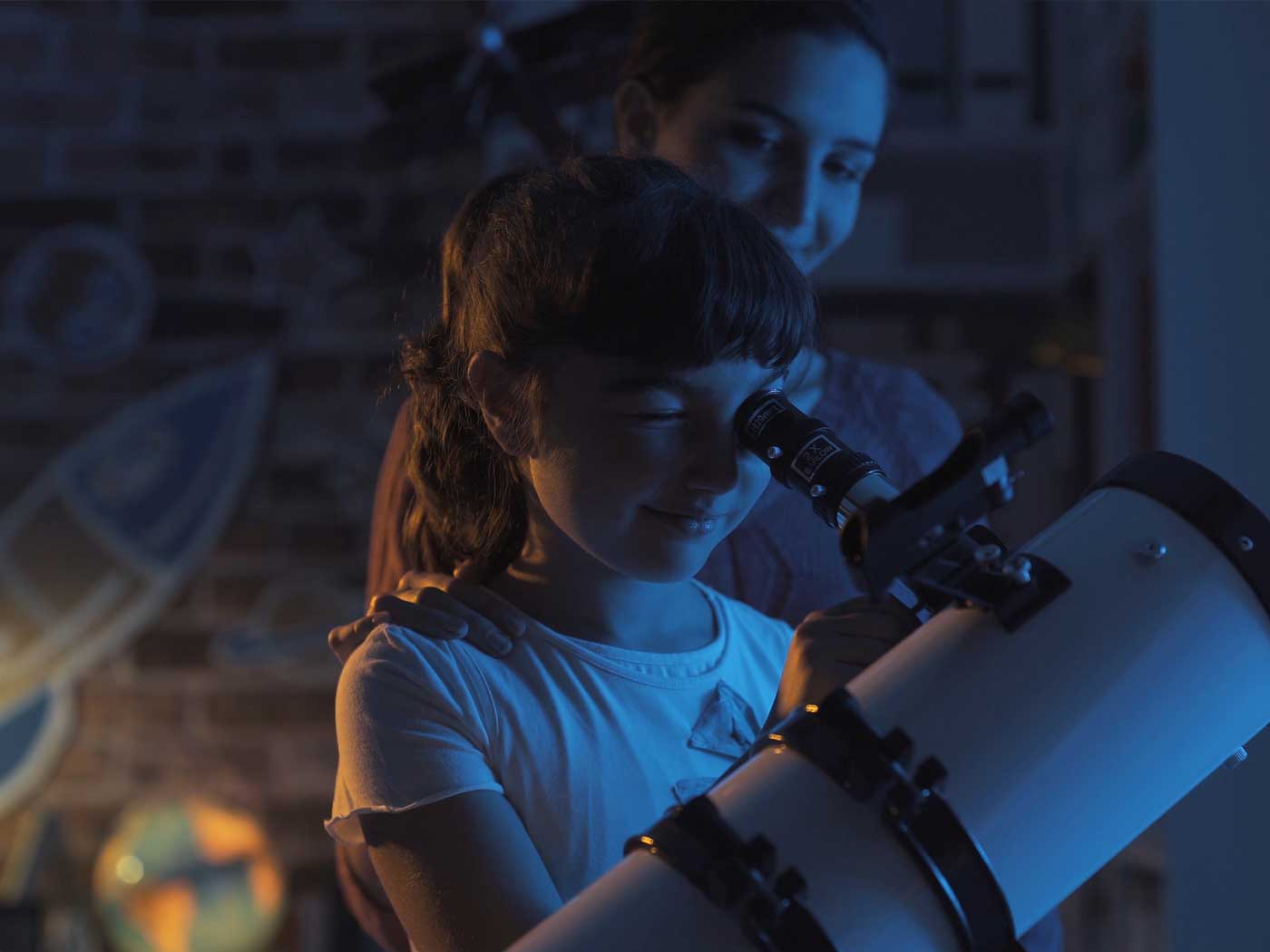Nowadays, there are many large fish with sharp teeth that roam the oceans seeking what they may devour. But as they feed on smaller fish and shrimp, their mouths begin to accumulate food debris and parasites. Lacking recourse to a toothbrush, how is such a fish going to clean its teeth?
For several kinds of fish, the answer is a visit to the local cleaning station. These are special areas usually marked by the presence of certain shrimp and small, brightly colored fish, such as wrasses and gobis.
Often fresh from chasing and eating other small fish and shrimp, a predatory fish may periodically swim over to take his place in line (literally!) at the nearest cleaning station. When his turn comes, he opens his mouth wide, baring the vicious-looking teeth.
You might suspect, of course, that such a sight would frighten off the little cleaner fish and shrimp. But, no. Into the jaws of death swim the little cleaners. Now even a friendly dog will sometimes snap at you if you try to pick off a tick, and it probably irritates the big fish to have a shrimp crawling around on its tongue and little fish picking off parasites in the soft tissues of the mouth. But the big fish just hovers there, allowing the cleaners to do their work. It even holds its gill chamber open so that the shrimp can crawl around on the gill filaments picking off parasites!
At the end of all this cleaning, the second miracle occurs. You might think the fish might respond, "Ah, clean teeth; SNAP, free meal!" But. no. When the cleaning is done, the big fish lets the little cleaner fish and shrimp back out again. Then the big fish swims off—and begins hunting again for little fish and shrimp to eat!
The fantastic relationship just described is called cleaning symbiosis. Perhaps you have seen cleaner fish in a major public aquarium, or seen pictures of their behavior in television footage or nature magazines. Cleaning symbiosis is a well-known example of mutualism, an intimate relationship of benefit to both kinds of species involved, in this case, the cleaned and the cleaner.
Obviously, cleaning symbiosis has survival value for both kinds of species involved. But does survival value explain the origin of this special relationship? Of course not. It makes sense to talk about survival value, or Darwinian "fitness," only after a trait or relationship is already in existence.
Darwin himself recognized the "hindsight" limitations of natural selection. Given a variety of beak types, for example, Darwinian selection helps to explain how different finches are distributed over the Galapagos Islands in accord with differences in food supply. But how did the different beak types originate in the first place? For the origin of such traits, Darwin turned to "the direct and indirect action of the conditions of life, and … use and disuse:"1 To explain the origin of new traits, Darwin and the evolutionists of the last century accepted pangenesis, an idea quite similar to Lamarck's concept of the inheritance of acquired characteristics. Since that concept has been discredited, it cannot, of course, be used to explain the origin of cleaning symbiosis.
But what about mutations? Modern, neo-Darwinian evolutionists explain the origin of new traits and relationships in terms of mutations, which are random changes in an organism's genetic code. Mutations certainly do occur and, indeed, are responsible for perhaps 1500-2000 hereditary abnormalities in human kind alone. But could mutations produce the coordinated set of behavioral adaptations necessary to originate cleaning symbiosis? The comments of two well-known evolutionary scientists are especially helpful in answering this question.
Nobel laureate Albert Szent-Gyorgi writes the following about a relationship much simpler than cleaning symbiosis. He is talking only about a young herring gull pecking at a red spot on its parent’s beak to elicit a food regurgitation response:
All this may sound very simple, but it involves a horribly complex underlying nervous mechanism.… All this had to be developed simultaneously [like the cleaner entering the big fish's mouth at the same time the big fish suspends his normal habit of eating small fish], which as a mutation has the probability of zero. I am unable to approach this problem without supposing an innate drive in matter to perfect itself.2
Szent-Gyorgi then goes on to coin the term "syntropy," by which he means some impersonal creative force that drives the evolutionary process upward.
The point is this: the study of nature itself has forced a brilliant scientist to postulate the existence of some sort of unobserved, impersonal creative force. Is it so unreasonable, then, to infer from our observation of order in nature the existence of a personal Creator God?
Garrett Hardin, textbook author and well-known evolutionary biologist, addresses this question rather directly in 39 Steps to Biology, a collection of Scientific American articles on broadly ecological topics. Hardin includes cleaning symbiosis with several other articles in a section called "Nature’s Challenges to Evolutionary Theory."3
In his introduction to this provocative collection of articles, Hardin contrasts the thinking of Charles Darwin with that of William Paley. In an earlier century, Paley had argued that design in nature pointed clearly to a Designer. Darwin (or at least the Darwinists) felt he had discovered the means (natural selection) that produced designs without a designer. Both ideas are really "explain-alls" (panchrestrons) ultimately incapable of scientific falsification, explains Hardin, but which concept best fits our observations of nature?
After previewing cleaning symbiosis and a number of other relationships, Hardin writes:
Such are only a few of the unsolved puzzles facing biologists who are committed to the Darwinian framework.... Is the framework wrong? Was Paley right? Think about it!3
What a sane and yet sensational idea. What a rallying point for both creationists and evolutionists. Notice what Hardin is saying.
First, he recognizes that both evolution and creation have a priori starting points, accepted by faith and incapable of scientific falsification. "A Creator God can obviously be used to explain any observation," says Hardin, but so can evolution. After all, if a species is surviving, it must be "fit to survive," and if it became extinct, it must not have been fit to survive. Both systems of thought are internally consistent.
But second, Hardin recognizes that both creation and evolution have scientific dimensions. Predictions and deductions from the creation model can be made and empirically tested just as easily as predictions and deductions from the evolution model. Our knowledge of cleaning symbiosis argues against the evolution model, for example, so that Hardin openly asks if that framework is wrong.
Third, Hardin also seems to recognize that the concept of creation, no less than the concept of evolution, can be logically inferred directly from the scientific data. "Was Paley right?" That is, is the kind of relationship observed in cleaning symbiosis the kind of relationship found only in created objects? If we can infer the existence of unseen creative human intelligence from certain archaeological artifacts, can't we infer the existence of supra-human intelligence from created patterns in the natural world?
Finally, "think about it." One cardinal aim of the science teacher is to help students develop skill in critical thought and an openness to a broad range of hypotheses. The Scopes trial showed it was foolish to teach only creation; is it any wiser to teach only evolution? A two-model approach can't be accused of indoctrination; can evolution only?
As Garret Hardin so perceptively observes, the challenge to evolution does not come simply from a few fanatics. The challenge to evolution comes from the study of nature itself. Even if various pressure groups (ironically operating under the guise of "academic freedom") succeed in repressing presentation of all views except evolution, the case for creation will still be presented. The case for creation will be evident in certain special ecological relationships like cleaning symbiosis; in integrated sets of adaptations such as we see in the chemical system of the bombardier beetle or the blood-shunting system in the human brain; and in the fantastic molecular interaction within cells, such as the relationship between DNA and protein.
Because of the way things have been made, the case for creation will always be present in the subject matter of science itself (Romans 1:18-20; Psalm 19:1-4). But, how fair and natural to call this to our students' attention and encourage them, in Hardin's words, to "think about it!"
Not every kind of order, or complex system, however, requires special creation as the explanation for its origin. Snails and pond weeds placed in a sealed aquarium, for example, will often develop spontaneously a complex and ecologically balanced relationship between carbon dioxide and oxygen consumption and production. Given the properties of snails and pond weeds, such a relationship develops from snails and pond weeds "doing what comes naturally" under the conditions involved. But would cleaning symbiosis develop from big and little fish "doing what comes naturally" in our present world? Of course not.
We can distinguish the stone implements produced by human creative effort from those shaped by time, chance, and erosion. Similarly, we can distinguish two kinds of order in the living world.
Some relationships in biology, even quite complex ones, are the natural results of certain given properties in organisms. As complex as they are, many food-web relationships and biogeochemical cycles develop spontaneously from the behavior of the organisms involved and the inevitable effects of limiting factors. As incredibly complex and well ordered as it is, reproduction in most organisms follows naturally from given behavioral patterns, anatomy, and the processes of meiosis and fertilization.

The Christian recognizes that such processes reflect the continuing care by which God faithfully upholds His creation (Colossians 1:16-17; Genesis 8:21-22). But some kinds of relationships point us back to the direct, completed, supernatural creative acts of God. Cleaning symbiosis is one of those relationships.
Incidentally, cleaning symbiosis is not confined to the fish described above. Just as incredibly, the Nile crocodile will open its mouth to a bird, the Egyptian plover, which walks in, picks off the parasites, and then is allowed by the crocodile to leave again! Even the cleaning symbiosis earlier described involves several species of predatory fish and cleaner fish and also several kinds of crustaceans like Pederson's shrimp. Each of these species would have to somehow randomly accumulate a coordinated set of mutations to develop this relationship—unless the relationship was directly created by God and then reproduced after its kind.
No doubt several other mutualistic relationships (those beneficial to both species) also originated with special creative acts of God. There are "dairy ants," for example, that tend herds of aphids, gathering food for them and "milking" them for honeydew in return. Then there’s the yucca moth that collects a ball of pollen, stuffs it into the seed chamber of the yucca plant, and then lays a few eggs. Since the larvae that hatch can feed only on developing yucca seeds, their growth is provided for; and since some seeds are left and this yucca cannot otherwise pollinate itself, the plant also benefits. And so on. It would be fun some day to write a book, "One Hundred Thousand Evidences of Creation," just describing such fantastic relationships and the special adaptations of the various kinds!
One other special feature of the created order is so obvious we often fail to notice it: its beauty. I once took a zoology class to hear a lecture on marine life by a scientist who had just returned from a collecting trip to the Philippines. Toward the end of his lecture he described the brightly colored fish he had observed below the 190-foot level. But then he said that at that depth in those waters all wavelengths of light were absorbed except for some blue. In their natural habitat, he said, the fish could not even see their own bright colors, so what possible survival value could the genetic investment in this color have? Then he challenged the students to pose that question to their biology professors.
The answer that came to my mind was suggested by Genesis 2:9, where we read that God created fruit trees not only good for food but also "pleasant to the sight." We normally expect to find aspects of beauty as well as utility in the artifacts of human creation; how much more should we expect beauty to abound in the handiwork of God! Even creationists seem to forget that God is not only the Great Engineer, but the Great Artist as well.
Unfortunately, just like the engineering marvels of God have been corrupted by mutations and other effects of the bondage to corruption occasioned by our sin (Romans 8:18-20), so its beauty has been marred. The God whose faithful care daily sustains what He has made will not leave it so. But with the creation that "groaneth in travail," we also wait for that time when "they shall not hurt nor destroy in all my holy mountain, but the earth shall be full of the knowledge of the Lord as the waters cover the sea" (Isaiah 6:11).
References
1 Darwin, Charles, 1859 (reprint 1963), Origin of Species, Washington Square Press, Inc., New York, p. 470,
2 Szent-Gyorgyi, Albert, 1977, "Drive in Living Matter to Perfect Itself," Synthesis 1, Vol. 1, No. 1, pp. 14-26.
3 Hardin, Garrett, ed. 1968, 39 Steps to Biology, W. H. Freeman and Co., San Francisco.
* Dr. Gary Parker is Chairman of Life Sciences at Christian Heritage College and Research Associate with the Institute for Creation Research in San Diego, California.












